Medieval History
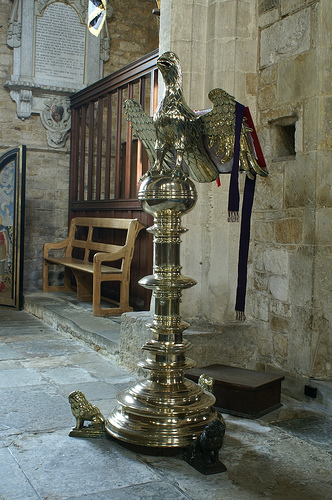
Lectern at Cropredy, Oxfordshire
Quite a number of medieval lecterns survive in English parish churches. Many of the surviving examples are fifteenth or early sixteenth century and are made of brass (latten). They take the form (as shown in the examples below from Cropredy in Oxfordshire and Croft in Lincolnshire) of an eagle of with its wings outstretched, perched on a large brass mond, which in turn is supported on a stem and a base, that sits on the backs of three little lions. Where these eagle lecterns where produced is a little unclear, some maybe English, but many are believed to have been fabricated in the Low Countries, which in the late Middle Ages had a thriving trade in luxury metal goods.
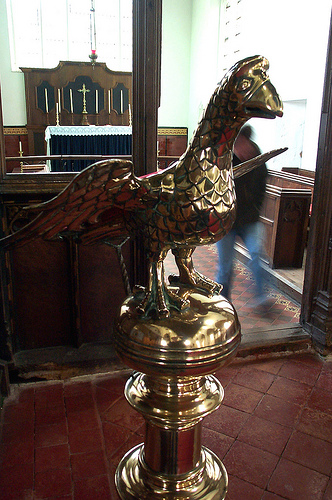
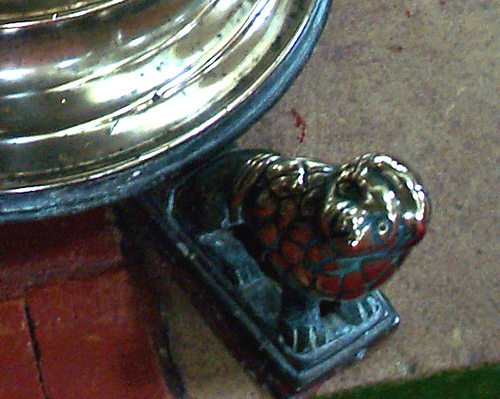
Most of the surviving English medieval lecterns are now to be found at the east end of the nave of a parish church, to one side of the chancel arch and supporting a large lectern Bible. That has not always been the case. Prior to the Reformation and the Advent of the large Bible for public use, these lecterns generally formed part of the furnishings of the chancel and were placed up close the high altar. The two early sixteenth century illustrations below, demonstrate how many of these lecterns were probably positioned.
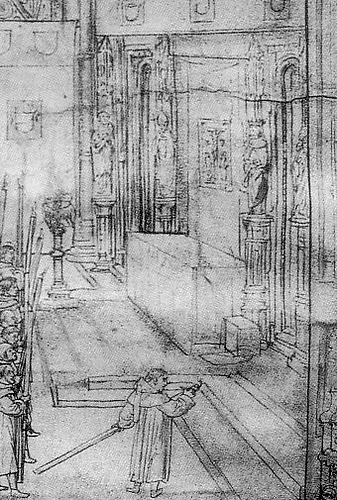
The first illustration is taken from the Islip roll and shows the high altar at Westminster Abbey as it appeared at the funeral of Abbot John Islip in 1532.
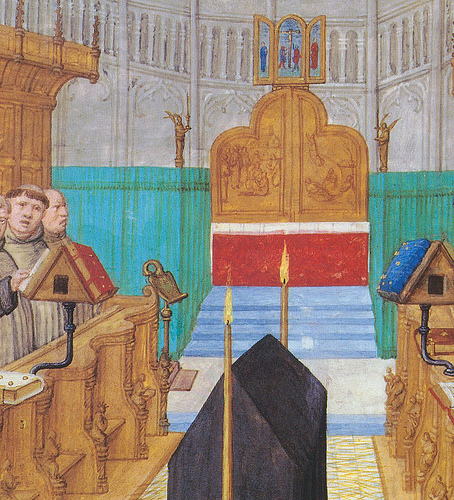
The second is from a Flemish book of hours of c.1516, which shows the office for the dead taking place in a wonderful Gothic interior. In both of these illustrations the lectern is placed in a similar position, at the bottom of the altar steps slightly to the north of the altar. The eagle, or in the case of the second illustration a pelican in her piety, are orientated to face towards the north. In this position the lectern was used as a support for the gospel book during the singing of the liturgical gospel at high mass. As is shown in this woodcut illustration (below) from Gherit van der Goude?s, Dat Boexken Vander Missen, the deacon faced towards the north to proclaim the Gospel, in order to avoid turning his back on the altar itself.

To be continued ... choir lecterns
- The Return Of The Croft Lions.
In December 2008 I posted the sad news that two of the little lions that support the base of the fifteenth century lectern at Croft in Lincolnshire had been stolen. The third couldn't be taken as it was soldered to the bottom of the lectern....
- The Rood Loft And The Liturgical Gospel
Here is an article for all you liturgical minded people out there, if you are not a medieval liturgical nerd like I am, read no further! The rood loft at Patrishow, Powys. There is a theory that in the late Middle Ages the rood lofts of...
- Theft
Croft, Lincolnshire, originally uploaded by Vitrearum.Yesterday I drove down to Croft near Skegness ostensibly to photograph the glorious fifteenth century brass eagle lectern that the church has. There are only two dozen of these in the country. My...
- Floor Levels - The Case Of Dorchester Abbey
Dorchester Abbey, Oxfordshire, originally uploaded by Vitrearum.The question of original floor levels in medieval church buildings came up in discussion on another post. Generally speaking the great ranks of steps you see in many of our medieval churches...
- The Hanging Pyx
Bodleian, Rawlinson A417, f 37v., originally uploaded by Vitrearum. The Blessed Sacrament was always reserved in a medieval church, for two reasons. Firstly so that it was always available to be taken to the deathbed of the faithful so that they could...
Medieval History
Gospel lecterns

Lectern at Cropredy, Oxfordshire
Quite a number of medieval lecterns survive in English parish churches. Many of the surviving examples are fifteenth or early sixteenth century and are made of brass (latten). They take the form (as shown in the examples below from Cropredy in Oxfordshire and Croft in Lincolnshire) of an eagle of with its wings outstretched, perched on a large brass mond, which in turn is supported on a stem and a base, that sits on the backs of three little lions. Where these eagle lecterns where produced is a little unclear, some maybe English, but many are believed to have been fabricated in the Low Countries, which in the late Middle Ages had a thriving trade in luxury metal goods.


Most of the surviving English medieval lecterns are now to be found at the east end of the nave of a parish church, to one side of the chancel arch and supporting a large lectern Bible. That has not always been the case. Prior to the Reformation and the Advent of the large Bible for public use, these lecterns generally formed part of the furnishings of the chancel and were placed up close the high altar. The two early sixteenth century illustrations below, demonstrate how many of these lecterns were probably positioned.

The first illustration is taken from the Islip roll and shows the high altar at Westminster Abbey as it appeared at the funeral of Abbot John Islip in 1532.

The second is from a Flemish book of hours of c.1516, which shows the office for the dead taking place in a wonderful Gothic interior. In both of these illustrations the lectern is placed in a similar position, at the bottom of the altar steps slightly to the north of the altar. The eagle, or in the case of the second illustration a pelican in her piety, are orientated to face towards the north. In this position the lectern was used as a support for the gospel book during the singing of the liturgical gospel at high mass. As is shown in this woodcut illustration (below) from Gherit van der Goude?s, Dat Boexken Vander Missen, the deacon faced towards the north to proclaim the Gospel, in order to avoid turning his back on the altar itself.

To be continued ... choir lecterns
- The Return Of The Croft Lions.
In December 2008 I posted the sad news that two of the little lions that support the base of the fifteenth century lectern at Croft in Lincolnshire had been stolen. The third couldn't be taken as it was soldered to the bottom of the lectern....
- The Rood Loft And The Liturgical Gospel
Here is an article for all you liturgical minded people out there, if you are not a medieval liturgical nerd like I am, read no further! The rood loft at Patrishow, Powys. There is a theory that in the late Middle Ages the rood lofts of...
- Theft
Croft, Lincolnshire, originally uploaded by Vitrearum.Yesterday I drove down to Croft near Skegness ostensibly to photograph the glorious fifteenth century brass eagle lectern that the church has. There are only two dozen of these in the country. My...
- Floor Levels - The Case Of Dorchester Abbey
Dorchester Abbey, Oxfordshire, originally uploaded by Vitrearum.The question of original floor levels in medieval church buildings came up in discussion on another post. Generally speaking the great ranks of steps you see in many of our medieval churches...
- The Hanging Pyx
Bodleian, Rawlinson A417, f 37v., originally uploaded by Vitrearum. The Blessed Sacrament was always reserved in a medieval church, for two reasons. Firstly so that it was always available to be taken to the deathbed of the faithful so that they could...
